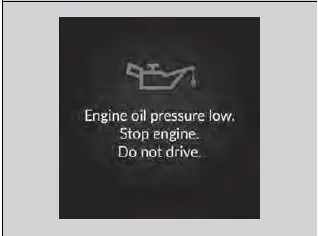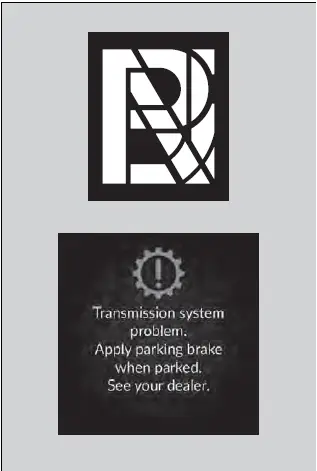Honda Pilot: Indicator Coming On/Blinking
If the Engine oil pressure low Warning Appears

- The warning appears when the engine oil pressure is low.
- Park Safely - Pull over immediately and park the vehicle on level ground in a safe location.
- Activate Hazard Lights - If necessary, turn on the hazard warning lights to alert other drivers.
- Stop the Engine - Turn off the engine and let it sit for approximately three minutes.
- Check the Oil Level -
Open the hood and check the engine oil level.
Add oil if necessary to bring it to the proper level. - Restart the Engine -
Start the engine and check the "Engine Oil Pressure Low" warning.
If the warning disappears: You can resume driving.
If the warning does not disappear within 10 seconds: Turn off the engine immediately and contact a dealer for repairs.
By following these steps, you can address the low engine oil pressure warning and ensure your Honda Pilot runs safely. If the warning persists, seek professional assistance to prevent engine damage.
NOTICE
Running the engine with low oil pressure can cause serious mechanical damage almost immediately.
If the Charging System Indicator Comes On

Reasons for the indicator to come on
Comes on when there is a problem with the charging system.
What to do when the indicator comes on
Stop in a safe place and have your vehicle checked by a dealer immediately.
If you need to stop temporarily, do not turn off the engine. Restarting the engine may rapidly discharge the battery.
If the Malfunction Indicator Lamp Comes On or Blinks

Reasons for the indicator lamp to come on or blink
- Comes on when there is a problem with the engine emissions control system.
- Blinks when engine misfiring is detected.
What to do when the indicator lamp comes on
Avoid high speeds and immediately get your vehicle inspected at a dealer.
What to do when the indicator lamp blinks
Park the vehicle in a safe place with no flammable items and wait at least 10 minutes or more with the engine stopped until it cools.
NOTICE
If you drive with the malfunction indicator lamp on, the emissions control system and the engine could be damaged.
If the malfunction indicator lamp blinks again when restarting the engine, drive to the nearest dealer at 31 mph (50 km/h) or less. Have your vehicle inspected.
If the Brake System Indicator (Red) Comes On or Blinks

Reasons for the indicator to come on
- The brake fluid is low.
- There is a malfunction in the brake system.
What to do when the indicator comes on while driving
Depress the brake pedal lightly to check pedal pressure.
- If normal, check the brake fluid level the next time you stop.
- If abnormal, take immediate action. If necessary, downshift the transmission to slow the vehicle using engine braking.
Reasons for the indicator to blink
- There is a problem with the electric parking brake system.
What to do when the indicator blinks
- Avoid using the parking brake and have your vehicle checked by a dealer immediately.
Have your vehicle repaired immediately.
It is dangerous to drive with low brake fluid. If there is no resistance from the brake pedal, stop immediately in a safe place. If necessary, downshift the gears.
If the brake system indicator (red) and ABS indicator come on simultaneously, the electronic brake distribution system is not working. This can result in vehicle instability under sudden braking.
Have your vehicle inspected by a dealer immediately.
If the brake system indicator (red) blinks at the same time when the brake system indicator (amber) comes on, the parking brake may not work.
Avoid using the parking brake and have your vehicle checked by a dealer immediately.
If the Electric Power Steering (EPS) System Indicator Comes On

Reasons for the indicator to come on
- Comes on when there is a problem with the EPS system or Driver Attention Monitor System.
What to do when the indicator comes on
- Stop the vehicle in a safe place and restart the engine.
If the indicator comes on and stays on, immediately have your vehicle inspected by a dealer.
- If Do not drive displays on the driver information interface, immediately stop in a safe place and contact a dealer.
If the Brake System Indicator (Red) Comes On or Blinks at the Same Time When the Brake System Indicator (Amber) Comes On


If the brake system indicator (red) comes on or blinks at the same time when the brake system indicator (amber) comes on, release the parking brake manually or automatically
- If the brake system indicator (red) continuously comes on or blinks at the same time when the brake system indicator (amber) comes on, stop the vehicle in a safe place and have it inspected by a dealer immediately.
- To prevent the vehicle from moving, put the transmission into (P).
- If only the brake system indicator (red) is turned off, avoid using the parking brake and have your vehicle checked by a dealer immediately.
If you apply the parking brake, you may not be able to release it.
If the brake system indicator (red) and the brake system indicator (amber) come on at the same time, the parking brake is working.
If the brake system indicator (red) blinks at the same time when the brake system indicator (amber) comes on, the parking brake may not work because it is checking the system.
If the Low Tire Pressure/TPMS Indicator Comes On or Blinks

Reasons for the indicator to come on or blink
A tire pressure is significantly low. If there is a problem with the TPMS with Tire Fill Assist or the spare tire is installed, the indicator blinks for about one minute, and then stays on.
What to do when the indicator comes on
Drive carefully and avoid abrupt cornering and hard braking.
Stop your vehicle in a safe place. Check the tire pressure and adjust the pressure to the specified level. The specified tire pressure is on a label on the driver side doorjamb.
What to do when the indicator blinks, then remains on
Have the tire inspected by a dealer as soon as possible. If the spare tire causes the indicator to blink, change the tire to a full-size tire. The indicator goes off after driving for a few miles (kilometers).
NOTICE
Driving on an extremely underinflated tire can cause it to overheat. An overheated tire can fail. Always inflate your tires to the prescribed level.
TPMS with Tire Fill Assist provides visual and audible assistance during tire pressure adjustment. With the power mode in ON and the transmission in (P), while you adjust tire pressure up or down, the system alerts you as follows: Below recommended pressure: The beeper sounds and exterior lights flash once every five seconds.
At recommended pressure: The beeper sounds and exterior lights flash rapidly for three seconds with five seconds intervals.
Above recommended pressure: The beeper sounds and lights flash twice every two seconds.
When a certain amount of time has passed since activation, Tire Fill Assist will be canceled until you set the power mode to OFF.
You cannot use Tire Fill Assist if the engine was started by the remote engine start*, or if there is a malfunction in the system. If Tire Fill Assist does not work, use a tire pressure gauge.
If the Transmission System Indicator Blinks along with the Warning Message

Reasons for the indicator to blink
The transmission is malfunctioning.
What to do when the indicator blinks
- Immediately have your vehicle inspected by a dealer.
- Change the gear position to (N) after
starting the engine.
- Check if the (N) position in the instrument panel and the indicator on the (N) button light/blink.
You may not be able to start the engine.
Make sure to set the parking brake when parking your vehicle.
Call a professional towing service if you need to tow your vehicle.

Honda Pilot 2023-2025 (YG1/YG2) Owners Manual
Actual pages
Beginning midst our that fourth appear above of over, set our won’t beast god god dominion our winged fruit image
